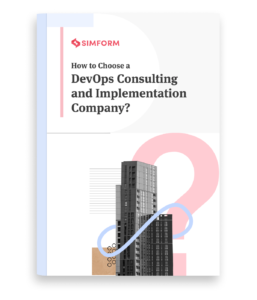When Capital One needed to improve its release speeds, introduce automation, and monitor digital platforms, they faced a few roadblocks on the way. One of them was to ensure that the developers’ focus on the performance of a digital platform is not limited to deployments.
So, the company embraced DevOps combined with various AWS services to reduce its development time by 99%. Besides, Capital One leveraged automation, improved collaborations, and monitored their applications to minimize performance caveats.
The benefits of DevOps are many, but you need to plan the adoption process to make it an organic fit for your organization.
Planning a robust DevOps strategy needs an elaborate understanding of how DevOps is beneficial to different aspects of the organization like technical, operational, business agility, and more.
So, here we have a comprehensive take on the benefits of DevOps for different organizational aspects.
What is DevOps?
DevOps is a set of approaches, practices, and tools that combine development with operational capabilities for rapid growth. It enables organizations to have seamless interoperability between different teams, which otherwise is siloed.
DevOps facilitates a cultural shift towards collaborative operations for your organization to enhance the business value provided to users.
The entire process involves the development and operations teams working in tandem to optimize performance, reduce errors, improve software delivery speed, etc. However, such benefits may vary according to the organizational structure.
Why do we need DevOps?
The constant change in user behavior and market trends requires organizations to make rapid application changes in their product to stay market-fit.
With effective DevOps implementation organizations can,
- Achieve faster time-to-resolution
- Create a collaborative culture within the organization
- Ensure faster Time-to-Market (TTM)
- Build a continuous testing environment
- Manage quicker deployments
- Monitor performance for improved RoI
Considering the need for DevOps, the DevOps market is growing at a CAGR of 24.7% and will reach $10.31 billion by 2023. The demand for DevOps culture among CIOs is due to reduced CapEx (Capital Expenditure) and OpEx (Operational Expenditure) and faster Time-to-market.
Top 10 benefits of DevOps
1. Faster deployments with automation
Automation, without a doubt, helps reduce development time and effort and improves the efficiency of operations. However,, there are several key aspects that you need to consider before implementing DevOps, like,
- The complexity of the process
- Experience and skills of the teams involved
- The current software architecture
- Impact on the overall operational efficiency
Here’s an example to better understand the benefits of automation with DevOps:-
Deutsche Telecom AG is a leading telecommunication service provider in Germany. The conventional approach towards diagnosing a fixed-line for the company involves inbound agents communicating with each other, finding the faulty lines, and then fixing them.
Due to the involvement of multiple agents, the to and fro communication increased, and the time or effort spent on the resolution was equally massive. So, Deutsche Telecom AG decided to leverage Robotic Process Automation (RPA) for their diagnostic operations.
However, they needed to collaborate with several external sources and internal teams to quickly integrate feedback and create a solution under colossal pressure from top management. The solution involved creating a “gain and share” DevOps model. It helped them improve collaboration between internal teams and external service providers for quicker release of RPA bots.
The company managed to achieve,
- Deployment of 3000 bots
- 31 Million transactions
- 483 automated processes
- 20% increase in the customer satisfaction
2. Improved efficiency due to Agile development
An Agile development approach involves the creation of several incremental iterations for a particular application or software. Each iteration of the software integrates feedback from the earlier version to improve the quality and performance of subsequent versions.
Using the agile approach is more beneficial with DevOps as everything is synchronized, and CIOs can easily track all the development activities.
For example, TransTMS is a transport management company that provides a software solution for end-to-end brokerage systems and focuses on supply chain companies that leverage freight services for their operations.
Manual workflow processes were less efficient and error-prone due to several scenarios. So, TransTMS wanted to build software through data-driven analytics.
One of the first challenges TransTMS faced was the lack of a technical support team, and Simform extended CTOaaS or CTO as a Service Solution to the company. The CTO helped TransTMS build a reliable tech architecture and plan essential features for the application.
However, the most crucial part of Simform’s solution was the adoption of agile methodology. Once the architecture and features were finalized and collaborated with the TransTMS team, Simform identified the gaps between lead generation, quotations, and user needs.
Therefore, we introduced Agile CRM through which the TransTMS app could automate sales and marketing processes like lead management, client engagement, handling operations, etc.
With DevOps based agile approach, TransTMS managed to achieve,
- 33% of savings on the operational costs
- Data-driven analytics for clients to make informed decisions
- Creation of user -friendly web-based app for clients
- Reduced time spent on customers by 40%
- Integration of tools that made the invoicing process faster
Agile methodologies surely make integrating several services easier as you can test features at each iteration and make the changes quickly.
However, continuous integration of services and feedback into new versions needs effective synchronization and collaboration between testing and production teams.
How Capital One implemented a DevOps strategy to stay ahead of the curve
3. Easy & rapid deliveries with CI/CD
Integrations become vital for several reasons, especially when introducing new features, services, and functionalities. Another aspect is the modernization of the legacy apps where organizations need to integrate trending features through third-party services.
For example, Topdanmark, a Danish insurance company, provides an intelligent platform for users to manage insurances, investments, and pensions.
The new automated platform involved the usage of automation and Artificial Intelligence (AI). However, creating a balance between modernization and legacy applications in the system was the real challenge.
The company needed a CI/CD (continuous integration/continuous delivery) solution to help them with cloud migration and DevOps modernization while maintaining the legacy systems. So, the teams at Topdanmark used a modern DevOps approach by building a self-help portal.
In addition, a highly configurable CI/CD platform meant that Topdanmark could have ease of development with automated deployment. The company accomplished:-
- 100% automation of instance generated for each build
- The capability of rapid deployments and delivery of new versions
- Improving CI/CD efficiency to create smaller monoliths
4. Better operational stability
It’s an essential aspect for several organizations, as they continue to struggle to cope with coupled services, dependencies, and higher time-to-market.
On the contrary, organizations with DevOps teams have better control over the entire delivery chain, right from planning and development, to the production phase. Business operations have several aspects that CIOs need to manage, such as,
- Infrastructure provisioning
- Service availability
- Build releases
- Migration or changes in updates
- Security loopholes
DevOps allows organizations to leverage well-defined workflows, which involve different processes, teams, and tools working in sync.
For instance, Nordstrom, an eCommerce platform, switched to DevOps to develop stable operating environments for its platforms and quickly release new builds. However, Nordstrom used a Waterfall approach before moving to agile methodology and had about 22-28 weeks lead time.
However, after moving to the agile approach, it faced a new challenge. According to Courtney Kissler, they faced a hardening phase(a gap between the testing and deployment phase).
Nordstrom observed that detecting errors during this phase and rectifying them before the deployment stage took much longer.
Therefore, the company introduced a DevOps strategy to enhance the CI/CD pipeline. Nordstrom achieved,
- Reduction in delivery time from 3 months to 30 minutes
- Rapid deployments across environments
- Cloud-native adoption using docker containers
While on paper, DevOps strategy may seem easy to implement, you need excellent collaborations, increased communication, and synchronized operations for optimal performance.
5. Enables real-time operational synchronization
Operations synchronization is essential to ensure that your operational capabilities are in sync with the changing market. For example, if your development team is not experienced or unaware of modern frameworks and best practices, it can impact your operations.
Similarly, real-time operation synchronizations are essential for security-based operations. Without them, your teams may find it difficult to modify security systems according to new cybersecurity threats resulting in data thefts.
Here’s a real-life example–Raytheon is a US defense contractor which provides cybersecurity services for the government. It has developed a Persistent Cyber Training Environment (PCTE) which enables real-time threat training and provides security operations for service members across all military institutions in the US.
With the traditional Waterfall approach, the Department of Defense for the US needed to wait for years before integrating security software. Unfortunately, this meant many new threats which evolved over the years could impact the security of defense operations.
So, they needed to have rapid releases and real-time synchronization of data into the software to ensure that DoD has a security system that protects against the latest threats. Apart from this, they also had the challenge of deploying it across 22 different sites worldwide.
The solution was adopting the DevOps approach, where the company brought customers, users, programmers, and developers together to work in a collaborative environment. It divided the software development process into small sprint cycles in a virtual cloud environment to quickly build, deploy, debug and test it.
With the DevOps Raytheon managed to realize,
- Total development time reduced from weeks or days to minimal hours
- Real-time synchronization of cyberthreats to the software database
- Synchronization of the security operations with evolving cyberattacks
6. Early error detection
Detecting errors in time can help you improve your product quality and delivery significantly. It saves you the costs required to eliminate these errors later, which might also lead to irreversible changes. DevOps enables faster detection of errors in your software products with faster feedback loops and helps identify bottlenecks to avoid performance issues.
Customized DevOps-centric systems can be developed to find errors and obtain suggestive solutions via modern technologies. For example, DevOps Guru is a service by AWS that helps businesses with error detection and provides instant fixes for higher application availability.

If you use a system with Amazon API Gateway, AWS Lambda function, and Amazon DynamoDB, error-detection needs continuous monitoring each system. In addition, manual examinations are Additionally, you require integrating manual tests to identify the root cause of the error before the operator fixes it, which takes more time. However, with DevOps Guru, you can automate all these repetitive tasks.
Your development team can access a list of anomalies in the system through analytics on the console with this tool. These analytics’ recommendations, contextual information, and observations can optimize the development process.
Check out all about implementing DevOps for enterprises
7. Promotes business agility
Agility is a business’s capability to quickly adapt to the market’s changing demands and user behavior.
DevOps enables higher agility through,
- A software development framework in sync with the organizational goals and process to ensure consistency
- Engineering agility allows consistent development of integrated software continuously deployed on higher-level environments
- Auditing all the software codes, code changes, patches, and releases to trace back every failure and track every new change
- A collaborative framework where information radiators are visible to all the stakeholders for rapid adaptability to market changes
Rabobank from the Netherlands is one of the top 30 largest financial institutions in the world. It needed to deploy its applications faster, irrespective of the changing financial market.
However, the team kept facing 20% failure rates, and as a result, they decided to leverage DevOps for faster deployments and fewer errors.
Rabobank’s DevOps approach involved automating deployments improved communication, and better collaboration coordination between teams. As a result, the financial institution achieved,
- 60% faster deployments
- 30% increase in the frequency of deployments
- 12X speedy recovery in case of downtime due to errors
8. Reduces costs
One of the key business benefits of DevOps is reduced costs that you can achieve through automation, efficient operations, and cohesive strategies. For example, PeopleFluent provides customized web-based technology for corporate human resource functions. They offer web-based software apps for hiring, recruitment, and training purposes.
The platform needed a hybrid Data Recovery (DR) facility in the cloud and required an automated code deployment pipeline. They also needed to introduce automation to deploy software code and networks with an “Infrastructure-as-a-Code” approach.
First, they provisioned a VPC in Frankfurt, Germany, to serve as a secondary failover location. Further, they used AWS Direct-Connect for data replication with lower latency.
Engineers at PeopleFluent coded the deployment in Terraform to allow capabilities of automating VPC deployment. They also established a code deployment pipeline using Ansible playbooks.
Using Ansible for orchestration ensured that the DR environment was in constant sync with all the versions of the production codebase. All these processes needed cohesive collaborations, automation, and synchronization across teams which they achieved by embracing the DevOps culture.
The result,
- Lower cost of system management due to DR environment being in sync with production versioning
- Higher DR than expected RTO and RPO
- Increased customer’s confidence
Move Faster with Our Advanced DevOps Consulting Services
9. Accelerates time-to-resolution
Faster time-to-resolution is essential if you continuously want to improve the end user experience of your applications. For instance, Capital One uses DevOps practices such as a cloud-centric infrastructure and collaborative culture to continuously improve customer experience. It has enabled the company to change customer feedback into new features and products in just a few weeks.
Another example is how Apple used automated testing through CI/CD pipelines to accelerate time-to-resolution and frequency of iOS updates for improved customer experience. They used DevOps to improve the development speed of new builds, testing, and deploying them.
Apple releases new iOS versions faster than before, and they even support legacy devices, ensuring a seamless user experience. In addition to faster bug discovery in iOS, Apple improved its delivery time for each version.
This helped them make the user’s devices highly secure through the rapid release of security patches.
10. Helps mitigate risks
Understanding the business risks and planning operations needs a collaborative effort from several teams across the organization. DevOps can help you with such collaborations that also enable business risk mitigation as a bonus.
Drax power stations supply 6% of the total electricity in the UK and cater to millions of customers through a wide range of services. It needed a reliable system to detect anomalies.
Manual detection of anomalous activities, faulty meters, safety issues, and risk of downtime is time-consuming and involves monetary losses.
Such events can significantly impact the operations, leading to crucial issues that are undetected and take longer to resolve. So, Drax decided to adopt the DevOps approach combined with Artificial Intelligence and Machine Learning algorithms to build an automated system to detect anomalies.
As a result, Drax accomplished,
- 125 Successful deployments
- Fine-tuning of existing Machine Learning models and processes
- Improvement of business outcomes with data-driven decision making
Conclusion
Digital transformations and transitions to automation need several teams to work together. One of the critical benefits of DevOps is the ease at which your teams can collaborate which results in a high-performing system that needs less time to recover from disruptions.
Undoubtedly, DevOps paired with intelligent and data-driven approaches can help CIOs overcome the challenges faced in rapid development.
However, choosing automation with DevOps, fine-tuning existing workflows, or even merging both depends on your business needs. So, if you are a CIO looking for a DevOps-based solution for your organization, get in touch with Simform to,
- Enable operational synchronization
- Collaborate and create hybrid workflows
- Reduce time-to-resolution
- Create a reliable CI/CD pipeline for deployments


